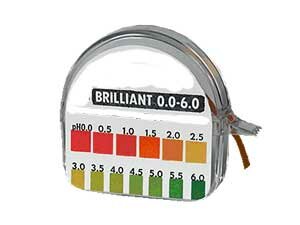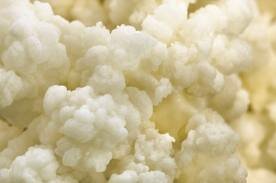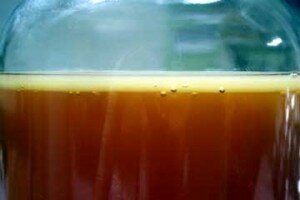Why Check pH Levels in the Kombucha Tea Beverage & Other Ferments?
Though pH readings is not always needed, adding pH checks to the culturing process helps to maintain proper viable and healthy culture strains/starter. Each type of starter culture will produce different amounts of acid as part of the fermentation process. Checking these levels, insure that your cultured foods and ferments are safe to consume. For the safety factor, all ferments should measure below 4.6 on the pH scale, as per FDA regulations. This insures that the cultured food is free of human pathogens, safe to consume, and that the desired bacteria/yeast cultures are viable and does not become overrun by foreign yeasts or bacteria.

How Does Fermentation/Culturing Work?
Fermented foods, which are foods produced or preserved by the action of microorganisms, are great for health and well-being of the body systems (especially the intestinal/gut system). In this context, fermentation typically refers to the fermentation of sugar to alcohol using yeast, but other fermentation processes involve the use of bacteria such as lactobacillus, including the making of foods such as yogurt and sauerkraut.
The art and knowledge of fermentation had been around for 1000’s of years and the scientific community calls it zymology. We call it wild fermentation or raw cultured foods.
It all starts by choosing the culture starter medium, such as kombucha tea culture or kefir grains, then ‘feeding’ the culture with the correct food source. After the recommended fermentation time the cultured food is ready to consume or used for making other cultured food products. An example would be making milk kefir and then using the ready cultured milk to make RAW living cheeses. Testing the pH before and after the process insures that the finished product is safe for consumption.
Many pickled or soured foods ferment, thus dropping the pH levels, as part of the pickling or souring process, like Japanese pickles. However, many preserved/fermented food stores go through a process of brining, vinegar induction, or the addition of other acidic foods sources such as lemon juice.
How to Test pH Correctly
Correct procedures when checking the pH levels allows for the most accurate readings. A short-range strip (o-6 pH) works the best over a broad range strip (0-14 pH). Human or saliva testing strips will not work due to the range of the product, from 5 – 8 pH. If you have purchased testing strips from us then the process is very easy. Simply open the roll of kombucha ‘test strip papers’ (0-6 pH range) and remove about an inch long piece of testing paper. Make sure the hands are clean and dry.
Check the pH reading by pulling a small sample of the ferment vs. placing the test paper in the ferment. Use a straw, spoon, or ‘wine thief’ to pull a sample to test. Dip the kombucha/culture test strip into the liquid to check. Then with a flick of the wrist, remove any excess liquid and immediately check the pH against the color-coded chart. The check should be within the desired range for the ferment tested, see below.
pH and Dairy Cultures

With dairy type cultures, such as milk kefir or yogurt starters, the pH is high to start with a drop in pH as the milk is cultured. There is not a starting point to check pH with dairy cultures. At the end of the process, the pH should read 4.5 or lower on a
color-coded pH chart.
pH and Water Kefir Strains

Water kefir grains act somewhat like the dairy kefir in that the initial pH test will be on the alkaline side of the scale. Depending on the strength of the old starter liquid, the test may fall within the correct range. Why we recommend use a slice of lemon to lower the pH and keep it below 4.5 pH.
pH and Kombucha Tea Cultures

For kombucha tea beverage, you should take two pH readings. One check is done when adding the starter tea to the new batch of tea/sugar solution and the second at the end of the brewing cycle.
This first pH test reading should be 4.5 pH or below, if it is too high then keep adding starter tea from your old batch
until the desired pH is reached.
Many kombucha recipes found online have a certain generic amount of starter tea added to a new batch. However, depending on the acidic strength of the old starter tea the amount added will vary from batch to batch. One may find that only a small amount is needed from a strong sour batch and much more required from a sweet batch of tea.
Adding the correct amount of starter, by reading pH, insures that the fresh tea solution is acidic enough to combat any human pathogens, foreign molds, or yeast.
Measure the second pH test at the finish of the brewing/culturing process. After your tea has brewed for the required amount for time, 7 to 14 days in most cases, then it is recommended to test the pH until it is at, or close, to 3 pH.
The desired range of the complete kombucha tea
is between 3.2 and 2.8 pH.
This reading tells you that the brewing cycle is complete and the tea is at the correct pH point to drink. Of course, this can very a bit to suit your needs and taste. If this final pH is too far on the alkaline side of the pH scale, then the tea will need a few more days to complete the brewing cycle.
pH and JUN Honey Culture

Many people now have access to the JUN honey culture. JUN is much like kombucha culture, yet a different strain and results. The ingredients in JUN are different from kombucha tea culture. Kombucha is made with black tea and cane sugar, whereas, JUN is created using honey and a lighter tea, such as white or green tea.
For checking pH levels, the steps and range is the same as kombucha tea.
We hope this post on checking kombucha pH levels in kombucha and other ferment will help in producing healthy and safe fermented beverages. See all our products at our culture store.
